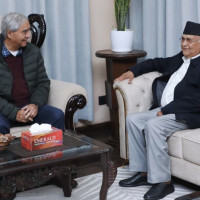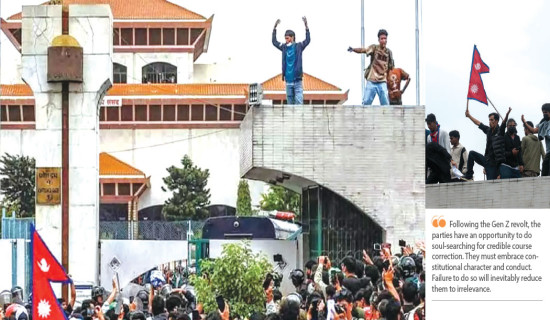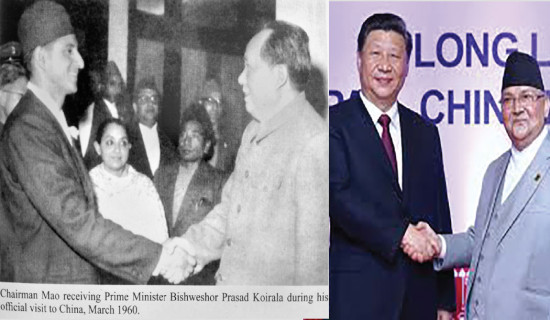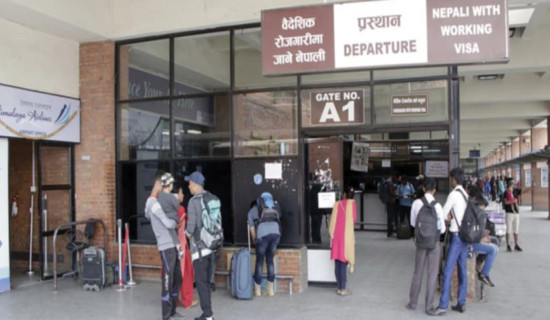- Saturday, 6 December 2025
70 Years Of Diplomatic Bond
Nepal-China Ties Reach Milestone
This year marks the seven decades of establishment of Nepal-China formal relations. The two nations are poised to observe the 70th anniversary of their diplomatic ties meaningfully, focusing on the speedy implementation of important common understandings and agreements they signed at different times. Nepal and China have maintained their sustained bonhomie throughout history. In ancient times, their relations were largely shaped by trade, art, culture, literature, security, matrimonial ties and high-level exchanges. In the modern era, their relations have grown qualitatively, with enhanced connectivity, economic cooperation, people-to-people contact and a flurry of high-level visits from both sides.
Nepal and China established their diplomatic relations on August 1, 1955, in the wake of historic changes sweeping across the world. Three months later, Nepal was admitted to the United Nations. In 1956, Nepal and the former Soviet Union opened their diplomatic channels. These developments were landmark in defining Nepal's foreign policy as they were a clear departure from Rana's India-centric and West-tilted policy. Nepal’s relationship with its northern neighbour provided the former with a reliable option to minimise economic dependency on India. In Nepal, China found a trustworthy friend who gave it a helping hand at critical junctures.
Nepal’s support
Nepal had played an important role in convincing the United Nations to grant membership to China. Nepal was one of the early nations to recognise the People's Republic of China after it became a communist nation and Tibet as its integral part. Nepal has continuously expressed its commitment to the One-China principle, strong opposition to ‘Taiwan independence’ and reiterated that Xizang matters are internal affairs of China while prohibiting any separatist activities against China on Nepali soil. These pledges on behalf of Nepal are a big boost to China in bolstering its security, sovereignty, territorial integrity and international image. This valuable support also holds significance given the geopolitical traction Nepal has gained in recent years.
A Treaty of Peace and Friendship that the Prime Ministers of both countries – BP Koirala of Nepal and Chou Enlai of China – signed in Kathmandu on April 28, 1960 – served as the basis of bilateral cooperation between the two nations. The Treaty stipulates that Nepal and China respect each other's independence, sovereignty and territorial integrity. Based on Panchasheel (the Five Principles of Peaceful Co-existence), it stresses the principle of equality and mutual benefits to promote and strengthen economic cooperation and cultural friendship between two nations, while settling their disputes through peaceful dialogue.
Former Nepali prime ministers Tanka Prasad Acharya, BP Koirala and kings Mahendra and Birendra, and Chinese leaders Chairman Mao, Premier Chou Enlai and Deng Xiaoping had played their pivotal roles in laying the foundation stone and expanding Nepal-China ties over the decades. Upon being elected the president of China in 2013, Xi Jinping accorded high priority to neighbourhood diplomacy, stating that this was necessary for the rejuvenation of the Chinese nation, a sound regional environment and common development. During Xi’s visit to Nepal in 2019, the Nepal-China relationship was elevated to a strategic partnership of cooperation ‘featuring ever-lasting friendship for development and prosperity’.
As the least developed nation, Nepal aspires to take advantage of China's mesmerising economic achievements and technological innovation to end poverty, generate jobs and attain prosperity. In the last seventy years, the two countries signed various important understandings and agreements, including Trade and Transit, and Belt and Road Initiative (BRI). At least 14 development projects related to highways, roads, education, health, disaster management and energy were constructed with the financial assistance of China, according to the website of the Foreign Ministry of Nepal. Similarly, around 21 projects that include a cross-border highway, expansion of the Kathmandu Ring Road Improvement Project and Syaphrubesi-Rasuwagadi Highway Repair, among others, are underway with Chinese support.
In 1956, Nepal and China inked an accord on ‘Economic Aid’ that provides guidelines for Chinese assistance to Nepal. China has been providing grant assistance to Nepal under the Economic and Technical Cooperation Programme since the mid-80s. Chinese financial assistance to Nepal falls into three categories: grants (aid gratis), interest-free loans and concessional loans. The Chinese support has greatly contributed to Nepal in the fields of infrastructure, industrialisation, human resource development, hydropower and sports, among others.
In the third week of January, Nepal and China organised a special function to celebrate the platinum jubilee of their diplomatic relations in Kathmandu, coinciding with the Chinese New Year 2025. Speaker Devraj Ghimire said that China had been a reliable and important development partner of Nepal for a long time. Similarly, the Chinese ambassador to Nepal Chen Song said that the recent agreement on the BRI Cooperation Framework had taken the China-Nepal strategic cooperative partnership to a new height.
Modality
However, there are challenges to implementing 10 projects identified under the BRI framework as the major political parties have failed to strike a consensus on the investment modality although the deal has spelt out ‘aid financing’ mode to execute them. The ruling Nepali Congress has stood against the idea of taking out Chinese loans and preferred grants. On the other hand, the communist parties, including the ruling CPN-UML, and opposition CPN-UML and CPN-Unified Socialist have insisted on both grants and soft loans to construct the BRI projects, a position that sounds pragmatic. The NC’s posture reflects more of a vested geopolitical interest than the national one. It is natural for Nepal to expect China to build one or two signature projects on grants but it is illogical to claim that all BRI projects should be constructed on grants.
No doubt, Nepal-China ties are smooth, stable and amicable. The 70th anniversary of their diplomatic relations offers another historic moment for a retrospective review of their friendship and to take practical steps in implementing the past and recent bilateral deals in a mutually beneficial manner. The leadership of both nations requires building greater trust essential for realising transformative projects that foster regional integration and connectivity and enable Nepal to achieve much-desired inclusive growth, thereby taking their relations into another historical stage.
(The author is Deputy Executive Editor of this daily.)

















